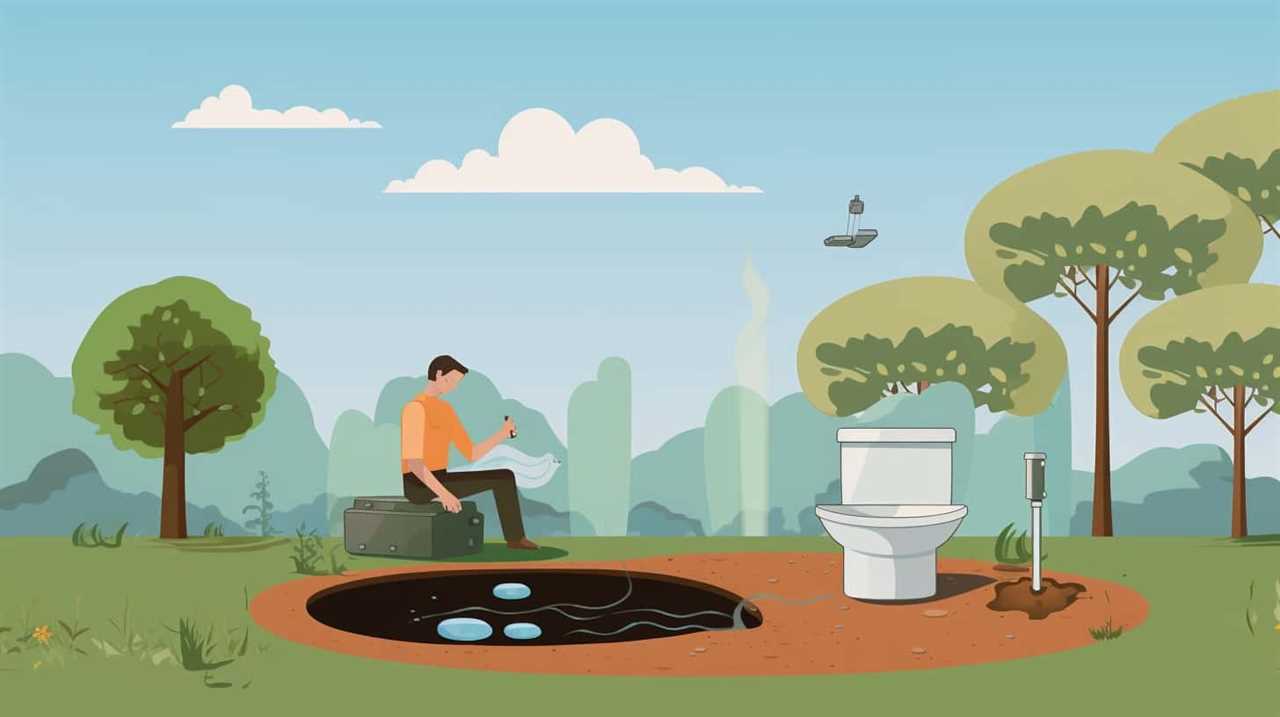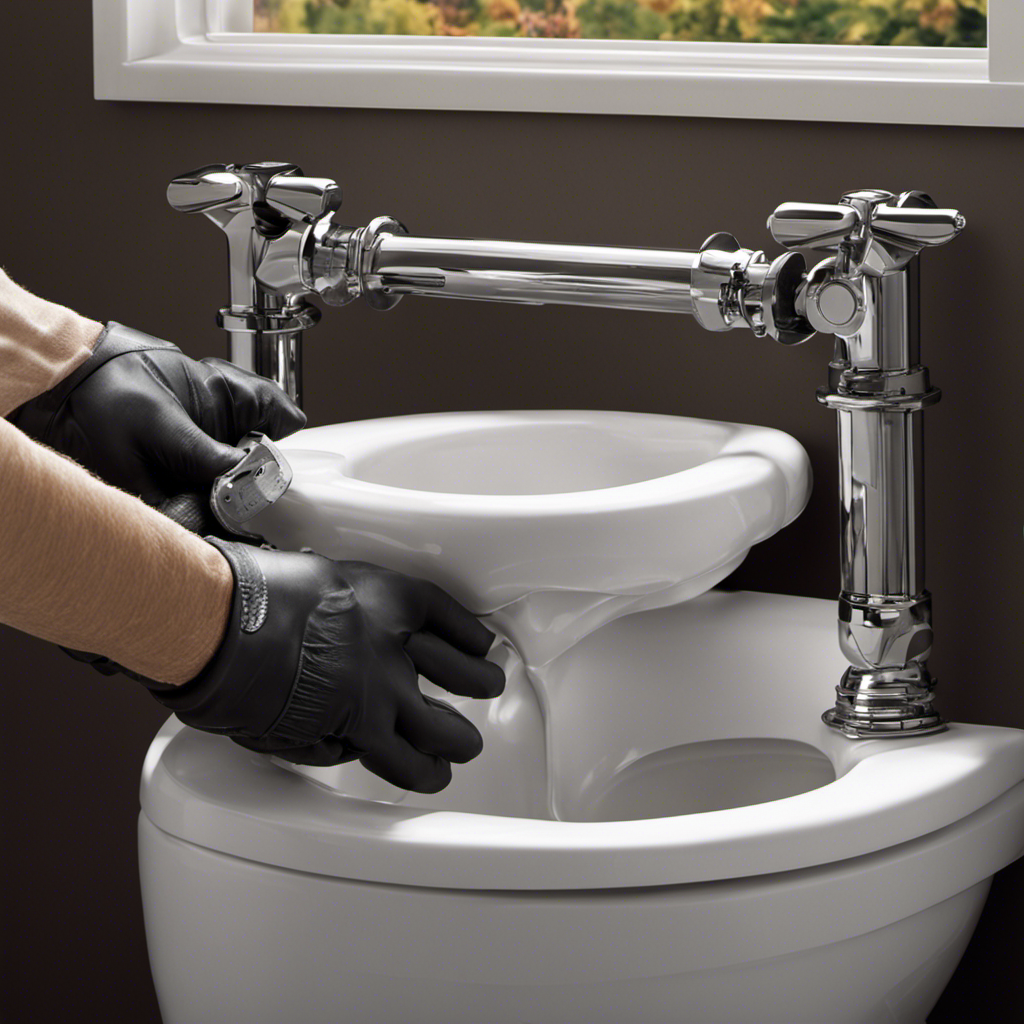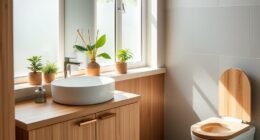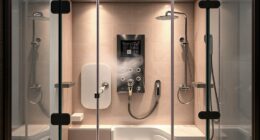Is the compatibility of dual flush buttons a standard feature? This is the key inquiry we aim to address in this article.
As homeowners, we all strive for efficiency and sustainability in our daily lives. The dual flush button, with its ability to conserve water, has become a popular choice for eco-conscious individuals.
However, navigating the world of dual flush buttons can be a daunting task. Join us as we delve into the intricacies of these buttons, exploring their universality and providing you with the knowledge to make an informed decision.
Key Takeaways
- Dual flush buttons are designed to conserve water in modern bathrooms by offering the option of a full flush for solid waste and a half flush for liquid waste.
- Different manufacturers have unique designs for dual flush buttons, ranging from simple push buttons to more complex mechanisms. Design compatibility with toilets is important for optimal functionality.
- Universal flush compatibility refers to the ability of dual flush buttons to work with different toilet models. While manufacturers strive to create universally compatible buttons, variations in size, shape, and placement can pose challenges.
- Common features of dual flush buttons include circular buttons with icons for full and half flush options, rectangular buttons with water droplet symbols, and triangular buttons with arrows indicating flush options. These features are effective in achieving water-saving goals.
The Importance of Dual Flush Buttons
Why are dual flush buttons important for modern bathrooms?

Dual flush buttons play a crucial role in water conservation, making them a vital addition to any modern bathroom. These buttons allow users to choose between a full flush for solid waste and a half flush for liquid waste.
By providing this option, dual flush buttons significantly reduce water consumption, which isn’t only beneficial for the environment but also helps to lower water bills.
The impact of dual flush buttons on the environment can’t be overstated. Traditional toilets use a large amount of water for every flush, resulting in unnecessary wastage.
However, with the use of dual flush buttons, the benefits of water conservation are realized, as less water is used for flushing, resulting in a significant reduction in water usage and a positive impact on the environment.

Understanding the Functionality of Dual Flush Buttons
We can understand the functionality of dual flush buttons by examining how they work and their benefits.
Dual flush buttons provide a more efficient way to conserve water in toilet flushing. The main advantage of dual flush buttons in water conservation is that they offer two different options for flushing, allowing users to choose between a full flush or a half flush. This means that for liquid waste, a smaller amount of water is used, while for solid waste, a larger amount of water is used. By having this choice, individuals can reduce water consumption significantly, as a significant amount of water is saved with each flush.
The mechanics of dual flush button operation involve a system that separates the water into two different volumes, depending on the button pressed. When the user selects the half flush option, a smaller amount of water is released, while the full flush option releases a larger amount. This mechanism allows for effective waste removal while minimizing water usage.
Variations in Dual Flush Button Designs
When it comes to dual flush buttons, one notable aspect is the variation in their designs. Different manufacturers often have their own unique button designs, which can range from simple push buttons to more complex mechanisms.

These variations raise the question of whether these different button designs are universally compatible with dual flush toilets or if they require specific matching models for optimal functionality. Understanding these design differences is crucial in ensuring that the dual flush button chosen is compatible with the toilet system it’s intended for.
Button Design Differences
Although there are variations in dual flush button designs, they all serve the same purpose of providing different flushing options. Button design aesthetics, ergonomics, and usability are important factors to consider when designing dual flush buttons. Aesthetics play a role in the overall design of the button, ensuring that it blends seamlessly with the toilet and bathroom decor. Ergonomics focuses on the comfort and ease of use for the user, ensuring that the button is positioned at a convenient height and angle. Usability refers to the clarity and intuitiveness of the button’s labeling and functionality. To illustrate the different button designs available, we have created a table below:
| Button Design | Aesthetics | Ergonomics | Usability |
|---|---|---|---|
| Round | Classic | Easy to grip | Intuitive |
| Square | Modern | Sleek | Clear labeling |
| Oval | Elegant | Comfortable | User-friendly |
| Rectangular | Minimalist | Space-saving | Clear instructions |
| Triangle | Unique | Eye-catching | Simple operation |
Universal Flush Compatibility?
As we transition into the subtopic of ‘Universal Flush Compatibility? (Variations in Dual Flush Button Designs)’, it’s important to consider the compatibility of different dual flush buttons in order to ensure functionality across various toilet models.
Universal flush compatibility refers to the ability of a dual flush button to work seamlessly with different types of toilets, regardless of the brand or model. While there’s no standard button design for dual flush toilets, manufacturers strive to create buttons that can be universally compatible. However, variations in button size, shape, and placement can still pose challenges when it comes to compatibility.

It’s crucial for buyers and installers to carefully review the specifications and measurements of the dual flush buttons to ensure they’ll fit and function properly in their toilets. Understanding the variations in dual flush button designs is essential to achieving successful universal flush compatibility.
In the subsequent section, we’ll explore the common features found in dual flush buttons.
Common Dual Flush Button Features
When examining common dual flush button features, it’s important to analyze the variations in button design and their effectiveness in saving water.
By comparing these design variations, we can determine which features are most effective in achieving water-saving goals.

This analysis will provide valuable insights into the universal aspects of dual flush buttons and the potential for standardization in their design.
Button Design Variations
Most dual flush buttons have several common design features. One of the button design trends is the use of ergonomic button design, which focuses on creating buttons that are comfortable and easy to use. This includes buttons that are large enough to be easily pressed, with a shape and texture that allows for a good grip.
Another common design feature is the use of symbols or labels to indicate the different flush options. These symbols are often intuitive and easy to understand, such as a half-filled circle for the half flush and a full circle for the full flush.
Additionally, some buttons may have a dual-action mechanism, where pressing the button halfway activates the half flush, and pressing it all the way activates the full flush. These design variations aim to enhance the user experience and promote water conservation.

Water-Saving Effectiveness Comparison
To compare the water-saving effectiveness of common dual flush button features, we can examine the quantifiable impact they’ve on reducing water consumption.
Water-saving technology is an essential aspect of dual flush buttons, as they aim to conserve water while maintaining efficient flushing capabilities. These buttons typically offer two options for flushing, a full flush for solid waste and a half flush for liquid waste. By providing users with the ability to choose the appropriate flush volume, water conservation measures are implemented.
Studies have shown that dual flush buttons can reduce water consumption by up to 50% compared to traditional single flush toilets. This significant reduction in water usage demonstrates the effectiveness of dual flush buttons in promoting sustainability and responsible water management.
Challenges With Non-Universal Dual Flush Buttons
In our experience, dual flush buttons that aren’t universal can pose several challenges. These challenges include:

- Compatibility issues: Non-universal dual flush buttons may not fit properly on all toilet models, resulting in a loose or unstable button. This can lead to difficulties in operating the flush mechanism reliably.
- Limited availability: Non-universal dual flush buttons may have limited options in terms of design, color, and style. This can make it challenging to find a button that matches the aesthetic of the bathroom or meets the specific preferences of the user.
- Maintenance and repair difficulties: Non-universal dual flush buttons may require specialized parts or tools for maintenance or repair. This can make it more difficult to fix any issues that may arise, potentially resulting in increased costs or the need for professional assistance.
Factors to Consider When Choosing a Dual Flush Toilet
Our top considerations when choosing a dual flush toilet include:
- Water efficiency: It’s important to look for toilets that have a high WaterSense rating or meet other recognized standards for water conservation. The effectiveness of the dual flush mechanism should also be evaluated to ensure that it effectively reduces water usage without compromising on flushing power.
- Durability: A well-built toilet will be less prone to leaks and other issues. Considering durability is important to ensure that the toilet lasts long and provides reliable performance.
- Ease of maintenance: Toilets that are easy to clean and repair will save both time and money in the long run. Considering the ease of maintenance is crucial in ensuring that the toilet requires minimal upkeep.
These factors are crucial in ensuring that the toilet not only saves water but also lasts long and requires minimal upkeep.
Exploring Universal Dual Flush Button Options
Now let’s delve into the question: ‘How can we determine if dual flush buttons are universal?’ When exploring universal dual flush button options, it’s important to consider the benefits of such designs.
Here are three sub-lists to draw you in and keep you interested:

- Ease of Use:
- Universal dual flush buttons are designed to be intuitive and user-friendly, making it easier for individuals of all ages and abilities to operate.
- These buttons typically have clear and simple labeling, ensuring that users understand the flushing options available to them.
- Universal buttons are often ergonomically designed, allowing for a comfortable and effortless flushing experience.
- Water Efficiency:
- Universal dual flush buttons promote water conservation by offering different flush options, typically a smaller flush for liquid waste and a larger flush for solid waste.
- By providing users with control over the amount of water used, these buttons contribute to reduced water consumption and lower utility bills.
- Universal button designs often incorporate mechanisms that optimize water usage, ensuring an efficient flush every time.
- Compatibility and Retrofitting:
- Universal dual flush buttons are designed to be compatible with a wide range of toilet models, making them suitable for both new installations and retrofitting existing toilets.
- These buttons can easily replace traditional single flush buttons, providing an economical and environmentally friendly upgrade option.
- The availability of universal button options ensures that consumers have access to a variety of styles and finishes to match their bathroom aesthetics.
Frequently Asked Questions
Are All Dual Flush Buttons Compatible With Every Type of Toilet?
Compatibility concerns and installation tips for dual flush buttons are important to consider. It’s crucial to ensure that the button is compatible with your specific toilet model to avoid any issues during installation or in the future.
How Do Dual Flush Buttons Contribute to Water Conservation?
Dual flush buttons significantly reduce water usage in commercial buildings. They can be integrated into smart home systems for optimal water conservation. Their impact on water usage is substantial, making them an essential tool for achieving water conservation goals.
Can I Easily Replace a Non-Universal Dual Flush Button With a Universal One?
Replacing dual flush buttons can be easily done by using a universal one. However, it is important to consider the compatibility of the universal dual flush button with your specific toilet model before making the replacement.
What Are the Main Differences Between the Various Designs of Dual Flush Buttons?
When considering the design of dual flush buttons, we must analyze the various options available. Differences can include size, shape, placement, and labeling. These elements greatly impact the user experience and must be carefully considered.

Are There Any Specific Maintenance Requirements for Dual Flush Buttons?
Specific maintenance requirements for dual flush buttons can vary depending on the design. Common problems include clogging, leaking, and button malfunctions. Solutions may involve cleaning, adjusting water levels, or replacing faulty components.
Conclusion
In conclusion, dual flush buttons aren’t universal as there are variations in their designs and functionality. This can pose challenges when it comes to finding replacement buttons or repairing existing ones.
However, it’s important to consider the features and factors when choosing a dual flush toilet. Exploring universal dual flush button options can provide a solution to these challenges, like a key that fits every lock.










